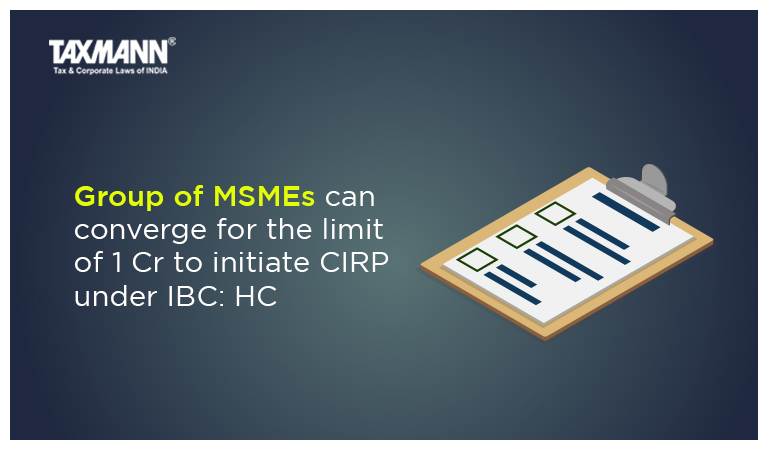Group of MSMEs can converge for the limit of 1 Cr to initiate CIRP under IBC: HC
- Blog|News|Insolvency and Bankruptcy Code|
- 3 Min Read
- By Taxmann
- |
- Last Updated on 27 August, 2022

Case Details: Vishnu Oil Mill (P.) Ltd. v. Union of India - [2022] 141 taxmann.com 408 (HC-Rajasthan)
Judiciary and Counsel Details
-
- Sandeep Mehta & Kuldeep Mathur, JJ.
- Hemant Kothari & Praveen Vyas for the Petitioner.
- Mukesh Rajpurohit, ASG Anuroop Singhi, VC Prasthant Tatia, Sheetal Kumbhat & Mahesh Thanvi for the Respondent.
Facts of the Case
In the instant case, the High Court dismissed the plea challenging the constitutional validity of section 7 of the IBC to the extent that it facilitates a joint application by multiple financial creditors to prove a minimum default of Rs. 1 crore.
The petitioner had approached the Court on being aggrieved by the order passed by the Adjudicating Authority (NCLT). The petitioner contended that previously the threshold limit for triggering the CIRP qua of the private financial creditors was Rs.1 lakh only. However, because of the serious financial distress brought around by the Covid-19 pandemic, the Government of India increased the minimum amount of default to Rs. 1 crore from the existing threshold of Rs. 1 lakh.
Further, the petitioner contended that while increasing the limit for initiation of the CIRP by a financial creditor either by himself or jointly with other financial creditors from Rs. 1 lakh to Rs. 1 crore, the clear intention of the legislature was that a joint application could be entertained, however, the individual liability towards each financial creditor should not be less than Rs. 1 crore.
The petitioner stated that the private respondents don’t claim an individual debt or default of Rs. 1 crore against the petitioner, however by unjustly invoking the provision of a joint application by the financial creditors u/s 7 of the IBC, the CIRP has been initiated against the petitioner which is an MSME.
Section 7(1) of IBC read as “a financial creditor either by itself or jointly with other financial creditors may file an application for initiating corporate insolvency resolution process against a corporate debtor before the Adjudicating Authority when a default has occurred.
According to the petitioner, the provision needs to be read in a purposive manner so as to lay down a principle that where the financial creditors filed a joint application u/s 7 of the IBC, the minimum default of Rs. 1 crore should be qua every individual creditor and the CIRP cannot be triggered on the basis of joint liability towards multiple financial creditors.
High Court Held
The High Court observed that there is no ambiguity in section 7 of IBC which requires any interpretation other than what is conveyed in its literal sense. Section 7 of the IBC clearly stipulates that the application for triggering the CIRP can be initiated by a financial creditor either individually or jointly with other financial creditors. Previously the threshold default limit for filing the CIRP application was only Rs.1 lakh and it has been drastically increased to Rs.1 crore vide Gazette Notification dated 24.03.2020
Further, the High Court observed that in cases of MSMEs, there may not exist financial creditors whose individual debt is Rs.1 crore or above. If the threshold limit was to be fixed at Rs.1 crore qua each individual financial creditor, then there was no reason whatsoever for allowing joint applications by financial creditors.
The High Court held that the statute and the amendment made therein makes it clear that the same was formulated in such a manner so as to provide a means of efficacious redressal to the smaller financial creditors and to give them an opportunity of availing the speedy remedy under the IBC rather than being relegated to other onerous proceedings for securing their money.
The High Court, further held that Section 7 of the IBC as amended vide Gazette Notification dated 05.06.2020, admits no other interpretation except that a group of financial creditors can converge and join hands to touch the financial limit of Rs.1 crore stipulated under Section 7 so as to initiate a CIRP under the IBC.
Disclaimer: The content/information published on the website is only for general information of the user and shall not be construed as legal advice. While the Taxmann has exercised reasonable efforts to ensure the veracity of information/content published, Taxmann shall be under no liability in any manner whatsoever for incorrect information, if any.

Taxmann Publications has a dedicated in-house Research & Editorial Team. This team consists of a team of Chartered Accountants, Company Secretaries, and Lawyers. This team works under the guidance and supervision of editor-in-chief Mr Rakesh Bhargava.
The Research and Editorial Team is responsible for developing reliable and accurate content for the readers. The team follows the six-sigma approach to achieve the benchmark of zero error in its publications and research platforms. The team ensures that the following publication guidelines are thoroughly followed while developing the content:
- The statutory material is obtained only from the authorized and reliable sources
- All the latest developments in the judicial and legislative fields are covered
- Prepare the analytical write-ups on current, controversial, and important issues to help the readers to understand the concept and its implications
- Every content published by Taxmann is complete, accurate and lucid
- All evidence-based statements are supported with proper reference to Section, Circular No., Notification No. or citations
- The golden rules of grammar, style and consistency are thoroughly followed
- Font and size that’s easy to read and remain consistent across all imprint and digital publications are applied





